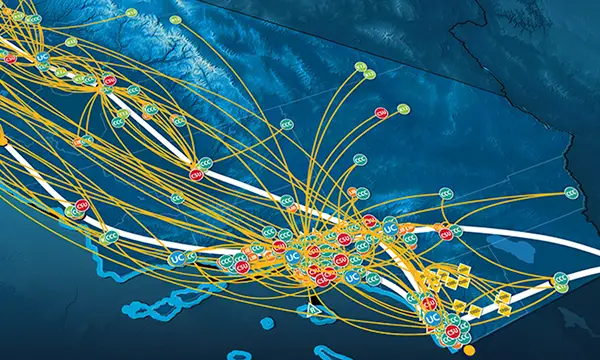- About
- Network
- Community
- Initiatives
- News
- Events
- Blog
- Publications

Life Inside CENIC: Sana Bellamine and Core Engineering
Categories RENS & NRENS The CENIC Community

When Sana Bellamine started working in the Core Engineering Department at CENIC in 2009, her role was to upgrade members to 1-Gbps broadband service. Years later, she worked migrating some of those same customers to 10-Gbps, then eventually to 100-Gbps, and most recently to 400-Gbps connectivity. Today, Bellamine works testing 800-Gbps solutions in preparation for the future.
Bellamine, a senior core engineer, and her team are instrumental in connecting millions of Californians with reliable and forward-thinking solutions, from basic broadband to advanced services with experimental networks. The Core Engineering team architects and designs the various networks that CENIC manages and supports, including the California Research and Education Network (CalREN) and Pacific Wave National and International Exchange, and is responsible for identifying new technologies and planning future directions in network infrastructure and services. Core Engineering deploys hundreds of new circuits each year, implements upgrades to the network backbone, provides expertise for escalation of requests from CENIC’s Network Operations Center, and provides technical expertise for a broad range of community projects.
“We introduce the newest technologies to benefit CENIC members, while staying ahead of members’ growing demands and delivering more resilient, more reliable, and more cost-effective services,” Bellamine said.
Core Engineering has recently completed projects to:
- implement 400-Gbps service across CalREN, and in doing so, CENIC was one of the first regional research and education networks to ever deploy a 400-Gbps superchannel;
- consolidate hardware on the CalREN Digital California (DC) and High-Performance Research (HPR) networks, an initiative that not only offered flexible use of the circuits, but also significantly reduced costs, streamlined operations, and decreased the network’s environmental impact; and
- offer members a cloud-based service to protect from Distributed Denial of Service (DDoS) cyberattacks, a critical and cost-effective solution to detect and mitigate growing DDoS threats, which have the potential to prevent people from accessing online resources, and in the worst cases, to take institutions offline completely.
Core Engineering interacts with every team within CENIC, with members across California, with providers of goods and services, and with colleagues, both nationally and internationally. The Core Engineering team is led by Director of Network Engineering Robert Kwon and includes a principal network architect, three senior-level network engineers, and six mid-level associate core network engineers.
Bellamine, who is originally from Tunisia, worked as the director of engineering at a major commercial Internet Service Provider prior to joining CENIC. Before that, she collaborated with the Network Startup Resource Center (NSRC), which supports the deployment of Internet networking technology to dozens of countries throughout the world, on teaching multiple international Internet Protocol (IP) routing workshops.
“Sana is a top-notch network engineer with global experience — from working in a team to set up the first Internet connection to Tunisia, to helping teach new network developers from 100+ different countries in the Global INET training programs in the 1990s, to recently (December 2018) teaching in the regional Arab States Research and Education Network (ASREN) program in Jordan,” said NSRC Director Steve Huter. “I've been fortunate to know Sana for 25+ years - she is a thoughtful and effective teacher in helping others learn how to build and operate Internet infrastructure.”
In 2016, Bellamine was recognized nationally when she was selected to participate in Women in IT Networking at SuperComputing (WINS), a National Science Foundation-funded collaboration created to remedy the vast gender gap in Information Technology, particularly in network engineering and high-performance computing.
Bellamine said she likes working at CENIC because she is exposed to a variety of engineering projects and challenges. Some of the challenges she encounters are prioritizing which new technologies to implement, and testing and validating new technologies prior to deploying them in the production environment for members to use. A point of pride for Bellamine is the amount of engineering work CENIC is able to accomplish in-house rather than paying to hire consulting firms. Bellamine said the values that drive her include integrity, honesty, and responsibility.
“Engineering is an art form,” Bellamine said. “Engineers can get inspired and come up with an idea, and then experiment with creative ways to solve a real-world problem. Similar to how an artist might experiment as part of a creative process, engineers test out innovative designs in order to find optimal networking solutions.”
Related blog posts
The Big Game Is Big Data: How CENIC and the California Research and Education Network Support Member Athletics
When Fresno State needed to connect to Pac-12 Enterprises to broadcast a live football game over CBS, the Chancellor's Office reached out to CENIC for what Pac-12 later called the smoothest turn-up they've ever experienced.
Enabling Network-Based Collaboration Around the World: A Tour of CENIC and Partner Network Maps
On the Network Maps page at the CENIC website, you’ll find maps of all the networks, peering facilities, and exchanges to which CalREN connects, showing how thousands of CENIC member institutions connect to CalREN and to colleagues all over the globe.


